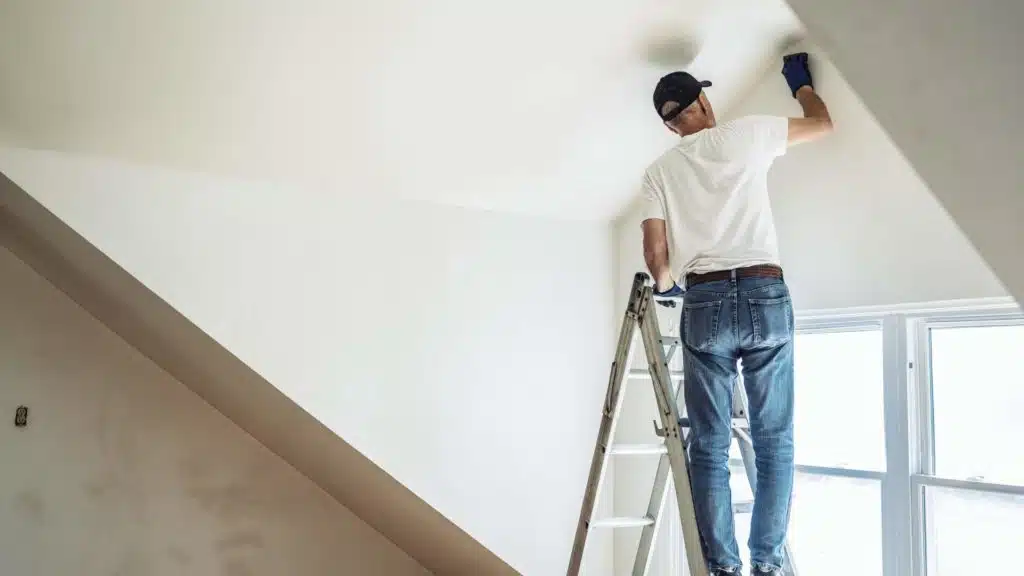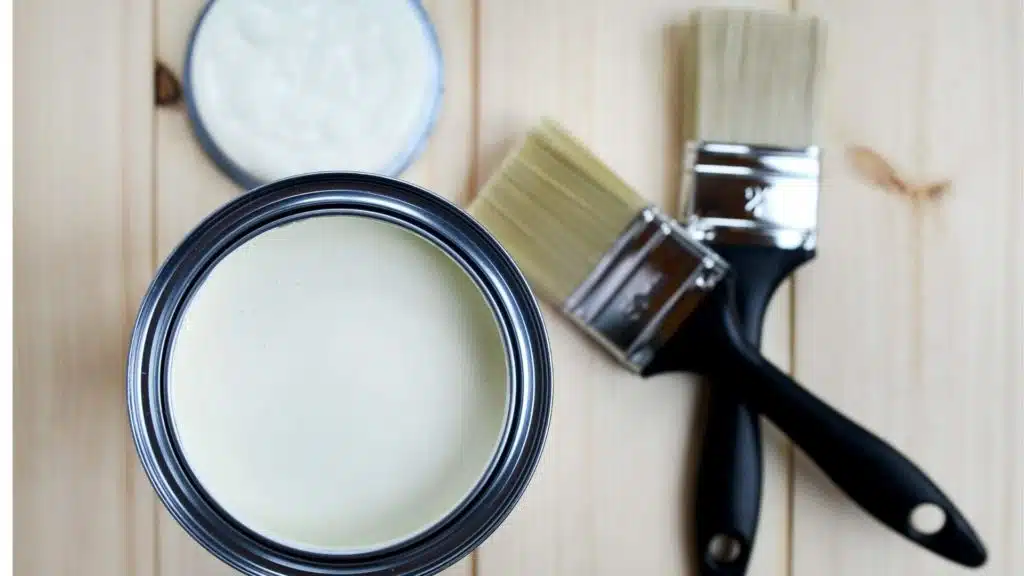You’re giving your walls a facelift.
You have just finished repainting the ceilings and have paint left over. Hmmm… Can you use ceiling paint on walls?
Great question! We’ve got you covered.
In this article, we take a look at the differences between wall paint and ceiling paint, instances when you can — and can’t — use ceiling paint, and who to call to get the best professional paint job in the Portland Metro area.
Table of Contents
- Can I Use Ceiling Paint on Walls?
- Is There a Difference Between Wall Paint and Ceiling Paint?
- 7 Differences Between Ceiling Paint and Wall Paint
- Additional FAQs About Using Ceiling Paint on Walls
- Can You Use Ceiling Paint on The Walls in a Closet?
- Can You Use Ceiling Paint to Prime Walls?
- Can You Use Wall Paint on Ceilings?
- What Is the Best Type of Paint To Use on Walls?
- Two Brothers Painting: Professional Painting Contractors in the Portland Metro Area
Can I Use Ceiling Paint on Walls?
The bottom line is no.
Ceiling paint was made for ceilings, not walls.
And while you may see some conflicting information online and our competitors may tell you something different, at Two Brothers Painting, it is our professional opinion that ceiling paint should not be used on walls.
Looking for a painting company in the Portland Metro area? Two Brothers Painting offers professional interior and exterior painting services. We believe in treating every customer the way we would like to be treated — while painting every home like it is our own.
Contact us today to learn more about the services we offer.
Is There a Difference Between Wall Paint and Ceiling Paint?
Yes!
Contrary to what many people think, ceiling paint and wall paint are not the same things. There are a number of differences between the two, including:
- Reflectability
- Coverage
- Durability
- Color options
- Ability to clean
- Viscosity; and
- Cost
7 Differences Between Ceiling Paint and Wall Paint
You may be wondering, “What’s the big deal? Why can’t I use ceiling paint on walls?”
Here are the seven main differences between ceiling paint and wall paint.
#1: Ceiling Paint Doesn’t Reflect Light
Most ceiling paint has a flat sheen finish.
This means the paint has very minimal reflective properties. A reflective or high-gloss finish would allow too much light to bounce off the surface, calling unwanted attention to the ceiling.
Wall paint, on the other hand, is typically an eggshell or satin finish. Eggshell is similar to a flat sheen, but has just a touch of reflection. Satin paint has a finish that is a little glossier than eggshell paint, but flatter than the sheen of a semi-gloss finish.
#2: Ceiling Paint Has a Higher Viscosity
The viscosity of ceiling paint refers to how resistant the paint is to spreading.
If you’ve ever used wall paint, you know how careful you have to keep an eye out for drips as you paint. That’s because wall paint has a low viscosity.
Ceiling paint contains more solids than wall paint and has a high viscosity — meaning it is nice and thick. The high viscosity of ceiling paint gives it greater adhering power than wall paint, so it won’t drip or splatter as much as when you use a roller to apply it.
Imagine trying to apply wall paint to a ceiling. You would be left with a drippy mess!
To get an even better feel of the viscosity of different types of paint, try this. Next time you go to the paint store, hold a gallon of wall paint in one hand and a gallon of ceiling paint in the other. You’ll immediately get a sense of the heaviness of the ceiling paint due to the higher volume of solids in the formulation of the paint.
#3: Wall Paint Doesn’t Cover as Well
As we just learned, wall paint has a lower viscosity than ceiling paint.
This means wall paint is thinner than ceiling paint, and can often require more than one coat to provide complete coverage.
Ceiling paint’s high level of viscosity means it has a greater level of coverage, easily hiding scuffs and other imperfections in the texture of the ceiling.
And since the coverage of a single layer of ceiling paint is much better than a single layer of wall paint, you can usually get by with one coat — meaning it takes less time and paint to get the job done.
#4: Ceiling Paint Doesn’t Withstand Cleaning
Another important difference between ceiling paint and wall paint is that wall paint comes in a variety of formulas.
Created especially for places like kitchens, bathrooms, and mudrooms, these formulas of wall paint are made to resist water, mold, and mildew.
They’re also able to withstand gentle scrubbing with soap and water, allowing you to easily remove marks and handprints to keep your walls looking fresh and clean.
Ceiling paint, on the other hand, is designed to be “dusted” rather than scrubbed and isn’t made to withstand the cleaning requirements of wall paint.
#5: Ceiling Paint Isn’t as Durable
Ceiling paint is not as durable as wall paint.
The high viscosity of ceiling paint means that a coat of ceiling paint goes on thinner than a coat of wall paint.
This means ceiling paint doesn’t have what it takes to withstand the bumps and scuffs that commonly assault walls. If used on walls, ceiling paint will easily become marred and will soon require repainting.
#6: Ceiling Paint Offers Limited Color Options
Ceiling paint is formulated for ease of application and to provide a dull, uniform appearance to the ceiling.
As a result, the options for ceiling paint are typically very limited. (However, you can always have custom colors mixed at a local paint shop.)
Wall paint, on the other hand, is available in a huge variety of colors options, such as:
- Very Peri
- Evergreen Fog
- Olive Sprig
- Alabaster
- Woven Wicker
- Agreeable Gray
- Morning Dew; and
- French Gray
#7: Ceiling Paint Costs Less
Ceiling paint is not as expensive as wall paint.
Ceiling paint’s ability to hide scuffs while providing exceptional coverage in a single coat also means you are spending less money on a gallon of ceiling paint than you would on wall paint.
That is why some people may consider using ceiling paint on the walls.
But while it seems as though ceiling paint would be a budget-friendly option, it is important to remember that with paint, the savings are always in the labor, not the paint. So if you use ceiling paint on your walls, but quickly wind up needing to have it repainted, you’re not experiencing a savings.
Additional FAQs About Using Ceiling Paint on Walls
Can You Use Ceiling Paint on The Walls in a Closet?
Yes.
The decision to use ceiling paint on walls is sometimes a matter of setting aside style for convenience.
For example, using ceiling paint to paint closets is an easy way to avoid the hassles of taping ceilings and baseboards when doing a renovation or painting a new building.
And if you do decide you want to add more style and color to your closets down the road, ceiling paint acts as the perfect primer.
Can You Use Ceiling Paint to Prime Walls?
Yes.
Many people use ceiling paint to prime walls.
Ceiling paint is excellent as a paint sealant and is the perfect substitute for primer if you have a leftover bucket of ceiling paint.
And ceiling paint’s flat finish and superior covering power also make it work great as a primer for door and window frames.
Can You Use Wall Paint on Ceilings?
No.
Wall paint is not like ceiling paint and cannot be used to paint ceilings.
Wall paint has a low viscosity, which makes it thin and much more watery than ceiling paint. This means it will be likely to drip if you try to use it to paint a ceiling.
Ceiling paint also lacks the durability needed for wall paint and does not lend itself to cleaning.
What Is the Best Type of Paint To Use on Walls?
For painting interior walls, the best opinions are either eggshell or satin paint.
Each of these paint finishes is known for:
- Durability
- Providing just the right amount of sheen; and
- Easy of cleaning
Semi-gloss and high-gloss paints are the best choices for woodwork and trim.
Two Brothers Painting: Professional Painting Contractors in the Portland Metro Area
Painting the interior walls of your home or office can be a messy and overwhelming project. That’s why you should consider calling in the professionals.
With over 145 years of combined experience, the seasoned team at Two Brothers Painting has what it takes to tackle your interior (or exterior) painting project with knowledge, confidence, and the utmost skill.
And as a family-owned business, Two Brothers Painting prides itself on responsive, reliable service — that is done right the first time.
Contact us to schedule an estimate today.





